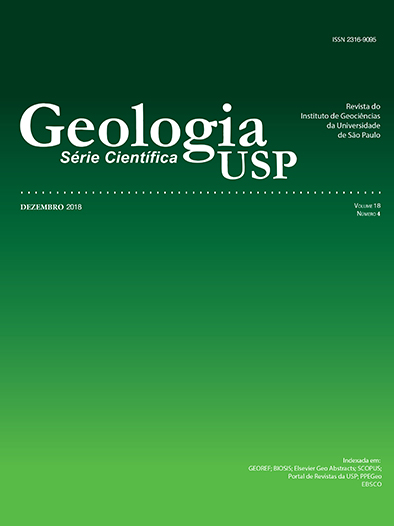Relação entre biofábrica e porosidade, coquinas da Formação Morro do Chaves (Barremiano/Aptiano), Bacia de Sergipe-Alagoas, NE-Brasil
DOI:
https://doi.org/10.11606/issn.2316-9095.v18-140513Palavras-chave:
Tafonomia, Coquina, Porosidade, Formação Morro do ChavesResumo
As coquinas da Formação Morro do Chaves são consideradas rochas análogas aos reservatórios da fase rifte do pré-sal nas bacias de Campos e Santos, são compostas principalmente por conchas e fragmentos de bivalves revelando uma grande variedade da biofábrica e do sistema poroso que possibilita o uso da tafonomia para relacionar o ambiente deposicional dessas rochas com as características de porosidade. Os principais atributos tafonômicos abordados nesse trabalho são: orientação das valvas; empacotamento das conchas; granulometria e seleção; e grau de fragmentação, abrasão e arredondamento. A interpretação dos dados teve como objetivo agrupar as amostras com relação às diferentes características tafonômicas e a porosidade, tendo como ferramenta auxiliar o método de redes neurais artificias (Self-Organization Map — SOM). A análise dos dados resultou em três agrupamentos: A1 com altos valores de porosidade (entre 11 e 23%), cujas características tafonômicas revelam ambientes de alta energia; A2 com valores intermediários de porosidade (entre 7 e 15%), cujas características tafonômicas indicam um ambiente de transição entre alta e baixa energia; por fim, o grupo A3 com menores valores de porosidade (entre 0 e 7%), cuja tafonomia indica ambientes de baixa energia. Como resultado final, as características tafonômicas revelam a energia do ambiente deposicional e é possível associar ambientes de alta energia com as altas porosidades para as coquinas da Formação Morro do Chaves.
Downloads
Publicado
Edição
Seção
Licença
Autores que publicam nesta revista concordam com os seguintes termos:
- Autores mantém os direitos autorais e concedem à revista Geologia USP. Série Científica, o direito de primeira publicação, com o trabalho sob a licença Creative Commons BY-NC-SA (resumo da Licença: https://creativecommons.org/licenses/by-nc-sa/4.0 | texto completo da licença: https://creativecommons.org/licenses/by-nc-sa/4.0/legalcode) que permite o compartilhamento do trabalho de forma não comercial e conferindo os devidos créditos autorais da primeira publicação nesta revista.
- Autores têm autorização para assumir contratos adicionais separadamente, para distribuição não-exclusiva da versão do trabalho publicada nesta revista (publicar em repositório institucional ou como capítulo de livro), conferindo os devidos créditos autorais da primeira publicação nesta revista.
- Autores têm permissão e são estimulados a publicar e distribuir seu trabalho online (em repositórios institucionais ou na sua página pessoal) a qualquer ponto antes ou durante o processo editorial, uma vez que isso pode gerar alterações produtivas, bem como aumentar o impacto e a citação do trabalho publicado (Veja O efeito do Acesso Aberto e downloads no impacto das citações).














